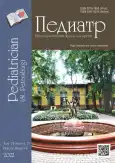Efferent therapy in pregnant women with the threat of very early premature birth with premature effusion of amniotic fluid. Two clinical observations
- Authors: Vetrov V.V.1, Ivanov D.O.1, Reznik V.A.1, Romanova L.A.1, Melashenko T.V.1, Kurdynko L.V.1, Vyugov M.A.2
-
Affiliations:
- Saint Petersburg State Pediatric Medical University, Perinatal Сenter
- Maternity Hospital
- Issue: Vol 13, No 4 (2022)
- Pages: 93-100
- Section: Clinical observation
- URL: https://journals.eco-vector.com/pediatr/article/view/114939
- DOI: https://doi.org/10.17816/PED13493-100
- ID: 114939
Cite item
Abstract
It is known from the literature that premature amniotic fluid expulsion in 22 weeks – 27 weeks 6 days gestation is very dangerous, as it is accompanied by high morbidity and mortality in newborn infants.
Clinical observation. This article presents the results of observing two women with premature amniotic fluid expulsion at 22 and 24 weeks’ gestation, respectively. In the first case, the woman was immediately admitted to the perinatal center; in the second observation, she was admitted after 3.5 weeks of treatment at another institution. In both cases, pregnant women had manifestations of oligo and endotoxemia, a protective inflammatory response in the mother-placental-fetal system (more pronounced in the second observation) against a background of urogenital infection. In the course of complex treatment, the patients underwent detoxification, of efferent therapy in the form of repeated consecutive sessions of plasmapheresis, hemosorption (one operation each), external photomodification of blood with ultraviolet, laser beams with prolongation of pregnancy by 10 and 8 weeks. The deliveries in both cases were operative with live babies with body weight of 1600 g and 1840 g, respectively. In the first case the infant did not need intensive care, was breastfed, in the second observation the newborn received active respiratory support for 9 days, in the dynamics his condition normalized. No septic complications in mothers and fetuses were observed.
The concluding efferent therapy in course of therapy were effected by prolongating of pregnancy with of good the results for mothers and them of fetus.
Full Text
About the authors
Vladimir V. Vetrov
Saint Petersburg State Pediatric Medical University, Perinatal Сenter
Author for correspondence.
Email: vetrovplasma@mail.ru
Dr. Sci. (Med.), Associate Professor, Department of Neonatology with courses of Neurology and Obstetrics and Gynecology
Russian Federation, Saint PetersburgDmitry O. Ivanov
Saint Petersburg State Pediatric Medical University, Perinatal Сenter
Email: doivanov@yandex.ru
ORCID iD: 0000-0002-0060-4168
MD, PhD, Dr. Sci. (Med.), Professor, Rector
Russian Federation, Saint PetersburgVitaly A. Reznik
Saint Petersburg State Pediatric Medical University, Perinatal Сenter
Email: klinika.spb@gmail.com
ORCID iD: 0000-0002-2776-6239
MD, PhD, Chief Physician of the Children's Clinical Hospital
Russian Federation, Saint PetersburgLarisa A. Romanova
Saint Petersburg State Pediatric Medical University, Perinatal Сenter
Email: l_romanova2011@mail.ru
MD, PhD, Department of Obstetrics and Gynecology
Russian Federation, Saint PetersburgTatiana V. Melashenko
Saint Petersburg State Pediatric Medical University, Perinatal Сenter
Email: melashenkotat@mail.ru
MD, PhD, Associate Professor of the Department of Neonatology with courses of Neurology and Obstetrics and Gynecology
Russian Federation, Saint PetersburgLyudmila V. Kurdynko
Saint Petersburg State Pediatric Medical University, Perinatal Сenter
Email: l.kurdynko@yandex.ru
Head of the Obstetrical Physiology Department
Russian Federation, Saint PetersburgMikhail A. Vyugov
Maternity Hospital
Email: mikhailvyugov@yandex.ru
MD, PhD, Anesthesiologist-Intensivist
Russian Federation, TaganrogReferences
- Vetrov VV, Ivanov DO, Sidorkevich SV, Voinov VA. Ehfferentnye i krovesberegayushchie tekhnologii v perinatologii. Rukovodstvo dlya vrachei. Saint Petersburg, 2014. 352 p. (In Russ.)
- Vetrov VV, Ivanov DO. Plod kak patsient transfuziologa. Saint Petersburg: Inform-Navigator, 2016. 112 p. (In Russ.)
- Vetrov VV, Ivanov DO, Reznik VA, et al. Methods of efferent therapy in prolongation of pregnancy in the isthmic-cervical insufficiency (two clinical observations). Pediatrician (St. Petersburg). 2019;10(1): 101–106. (In Russ.) doi: 10.17816/PED101101-106
- Vetrov VV, Ivanov DO, Reznik VA, et al. Results of efferent therapy in monochorionic diamniotic twins with dissociation of fetal development (three clinical observations). Pediatrician (St. Petersburg). 2019;10(2): 111–120. (In Russ.) doi: 10.17816/PED102111-120
- Ivanov DO, Atlasov VO, Bobrov SA, et al. Rukovodstvo po perinatologii. Saint Petersburg: Inform-Navigator, 2015. 1214 p. (In Russ.)
- Ivanov DO, Yuryev VK, Moiseyeva KЕ, et al. Dynamics and forecast of mortality among newborns in obstetric organizations of the Russian Federation. Medicine and health care organization. 2021;6(3):4–19. (In Russ.)
- Nechaev VN, Lisitsyna AS. Sostoyanie novorozhdennykh v zavisimosti ot dlitel’nosti bezvodnogo promezhutka i infektsionnogo protsessa u materi. Proceeding of the VII Regional Scientific Forum “Mat’ i ditya”; 2014 Jun 25–27; Gelendzhik. Moscow, 2014. P. 336. (In Russ.)
- Nikolaeva AE, Kutueva FR, Kutusheva GF. Sovremennye metody diagnostiki prezhdevremennykh rodov v ambulatornom akusherstve. Proceeding of the VII Regional Scientific Forum “Mat’ i ditya”; 2014 Jun 25–27; Gelendzhik. Moscow, 2014. P. 101. (In Russ.)
- Voinov VA, Vyugov MA, Vetrov VV. Plazmaferez pri rezus-nesovmestimoi beremennosti i gemoliticheskoi bolezni ploda i novorozhdennogo. Nauchnyi zhurnal ginekologii i akusherstva. 2019;2(2):001–004. (In Russ.)
- Tsinzerling VA, Mel’nikova VF. Perinatal’nye infektsii: Voprosy patogeneza, morfologicheskoi diagnostiki i kliniko-morfologicheskikh sopostavlenii. Saint Petersburg: Ehlbi SPb, 2002. 352 p. (In Russ.)
Supplementary files
















